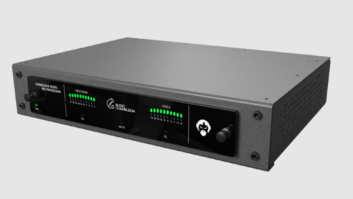Until now, searching for broadcast radio or podcast content on the internet hasn’t been easy. The best you could do is Google the name of the broadcast or podcast, topic and speaker you were interested in, and see what came back. If Google did deliver relevant broadcast/podcast suggestions, the link descriptions were based on text provided by the broadcast/podcast producers with the content, not the actual audio itself.

Fortunately, the Dark Ages of audio search appears to be over with the advent of www.audioburst.com.
Enter a topic into Audioburst’s search engine — perhaps “North Korea” — and the search engine will return an audio clip relevant to this subject, culled from a radio show or podcast available online.
In the case of North Korea, Audioburst called up a segment of “Noon Report with Rick Van Cise” from KOMO News (1000 AM/97.7 FM) in Seattle, just one minute after it had aired live.
I could then listen to the relevant short clip — literally an “audio burst” of sound one-to-three minutes in length — then let the Audioburst player go directly to another North Korea-related audio file, this time from Ray Appleton on 580 KMJ News/Talk Radio in Fresno, Calif. Or I could opt to listen to the entire “Noon Report” radio show, or instead search for another topic that appealed to me.

“Audioburst can offer a true audio search engine because our AI [artificial intelligence] engine ‘listens’ to millions of live streams across the web, searches for podcasts and ingests audio from partner radio stations and podcasters,” said Assaf Gad, Audioburst’s vice president of marketing and strategic partnerships. “You can access audio content using our search engine and other search engines like Google and Bing via a computer/smartphone keyboard, or ask for what you want through an internet-connected smart speaker, like Amazon Echo or Google Home.”
It is the ability to search for audio clips when listeners ask for them aloud that sets this search engine apart.
“When you vocally ask Amazon Echo’s Alexa to search Audioburst for specific radio news stories, you can get the actual audio stories played back to you, rather than descriptions of their links,” Gad said. “Suddenly, the wealth of broadcast/podcast audio that’s online is easily available to you.”

HOW AUDIOBURST DOES IT
On the surface, the notion that Audioburst’s AI can listen to online audio, categorize it, and make it accessible to listeners via text or voice search seems pretty cool.
Dig deeper and one discovers that Audioburst’s audio search technology is, in fact, extremely cool.
“Our system’s core technology listens in real-time to online sources of audio content, and processes it on two levels,” said Gad. “In the first level, the audio is fully transcribed to text using our ASR (automatic speech recognition) software engine. This text then goes through our NLP (natural language processing) algorithm: It allows us to understand what is being said, and to use this information to categorize, classify and store each topic for online searching.”

In the second level of the Audioburst process, the company’s Segmentation engine analyzes the content to find out when each topic starts and stops, allowing the system to assign discrete “In” and “Out” times to its Audioburst clips. These are the “audio bursts” that are then accessed and presented to users whenever the Audioburst search engine is used.
The format is designed to align with the limited attention span of 21st-century content consumers.
“Today most people don’t have the patience to ensure hours of audio to hear the specific segment they are interested in,” said Gad. “This is why our Segmentation engine is so important: It helps listeners go right to the topic they’re interested in immediately, and moves them to the next relevant clip when discussion of their preferred topic ends in the first audioburst.”

THE BUSINESS CASE
As a technology, Audioburst is, as we have said, cool. But what is the business case for an AI-enabled audio search engine? How is money to be made?
According to Assaf Gad, there are many ways for participating broadcasters/podcasters to profit from working with Audioburst.
“In themselves, Audioburst can create more listeners for specific broadcasts and podcasts, due to our users discovering these sources through our search engine and others like Google or Bing,” he said. “Audioburst can also be hosted on a range of web sites as they are created, and be used as links back the content creators’ own websites.” For broadcasters and podcasters, this provides the option to sell ads on those third-party sites, and to increase traffic on their own ad-populated sites.

Search for “Paul Manafort,” “North Korea,” “Donald Trump” or any other term, and you’ll get a variety of results — podcasts, radio programs, audio clips and other relevant content.
Gad also foresees adding onscreen commercials and sponsored links to the Audioburst search results page; just like Google’s results page displays sponsored content now. Audioburst is also compiling “customized playlists” for its users — content suggestions derived from each person’s historical topic choices and preferred audio sources — that can be sponsored entirely or in part by advertisers.
“Any revenue we make can be shared with our content production partners,” he said. “There are real opportunities to remonetize their existing audio content, by working with Audioburst.”
The company seems to have solved the riddle of making audio searchable on the web, and that is no small achievement. Will Audioburst’s profit potential prove to be as strong as its cool factor?












